Edd Morris is the author of ‘Exploring English Castles: Evocative, Romantic, and Mysterious True Tales of the Kings and Queens of the British Isles.’
‘Exploring Castles was published in the UK in July 2015.
To buy:
Follow Edd Morris on Social Media:
Edd’s Website: Exploring Castles
Twitter: @ExplorinCastles
Many thanks to Edd for answering my questions.
Why did you decide to write this book?
I’ve been blogging about castles for quite some time [on www.exploring-castles.com]. I love geography, literature, history… I think I’ve approached writing about castles more from the perspective of a humanities student than as a Medievalist, or a military historian. I’ve always wanted to try and capture the human stories, the plots, the struggles which occurred within the walls of these fortresses, rather than simply re-telling a list of dates or facts.
I was approached by a publisher in New York who was interested in my site and asked if I’d like to put together a book proposal. Obviously I jumped at the chance!
What makes your book different from other books about castles?
For each of the castles featured in the book – there’re nine, plus a general introductory section – I’ve tried to depict the history of the castle through an important siege, a state visit, or political struggle. That means – for Kenilworth Castle, for example – I’ve written about Elizabeth I’s summer visit to the fortress, and Robert Dudley’s attempts to secure her hand in marriage.
What was your criteria for choosing the nine castles featured?
That’s quite tricky! I agonised about this for quite a while. I guess one important motive was that I wanted to act as a cheerleader for forgotten but important castles – that’s why I eschewed the likes of Warwick.
I wanted to showcase a geographical spread of castles across England, and I also wanted to demonstrate that castles are quite, well, a heterogenous species – some, like Dover, can be vast fortresses, whereas others, like Goodrich [Herefordshire] we actually quite homely.
Which castles didn’t make the book?
There’s a handful of castles which I’d have liked to cover, but didn’t work within the overall structure of the book. The most obvious omission is the Tower of London. Simply because so much has happened there, it was very difficult to create a clear narrative without constantly flicking between historical periods. I felt that I couldn’t do the Tower justice, so I decided not to include it.
I’d like to have covered Pontefract Castle – it’s a personal favourite, and it used to be one of the biggest castles in England with a fascinating history (it held out through the sieges of Civil War, but the locals campaigned for its destruction once the battle was done). It was a terrifying place full of gruesome stories – but it’s almost entirely destroyed, so visually it didn’t work in a book with so much photography.
Do you have a favourite out of the nine castles?
Yes, most definitely – Goodrich Castle in my home county of Herefordshire. It’s this blood red sandstone fortress, which lies near to to the banks of the River Wye. It kind of encapsulates everything that’s so interesting about a castle: the intriguing ruins of once luxurious rooms, contrasted to the might of the portcullis and drawbridge. You approach it slowly via a path through fields, and it’s quite magic as it emerges into view.
How did you choose the ‘snapshot of one of the most notable moments in the past’ for each castle?
This was another tricky decision. I wanted to have a spread of stories from different time periods, rather than just honing in on the Medieval period. Actually, a lot of castles in the UK have a similar sort of life-cycle: founded in Medieval times; perhaps aggrandised during the Tudor period; and then used during the Civil War for siege. Subsequently most castles were ruined – either intentionally or accidentally.
I tried to find interesting stories from each period – associated usually with one central, understandable figure. I then set out a book structure which included as wide a variety of geographies, and of time periods, as possible.
Why did you choose Framlingham castle, where Mary Tudor raised her standard against Queen Jane in July 1553?
Well, there’re quite a few reasons. Today the castle is still spectacular – you can climb up to the dizzy heights of ‘wall walk’, which connects many of the castle towers, and has a great view across the countryside. On one side of the fortress, there’s a deep, dark mere: it’s very impressive.
What’s so interesting, though, is that this castle used to be one of the most beautiful residences in southern England in Tudor times – a real jewel. It was beautifully aggrandised in the 1500s, with these incongruous, slender red chimneys – built to echo the chimneys of Hampton Court, but attached to the Medieval castle towers! It’s hard to get a true sense of the luxury, but this grandeur was so important to Mary Tudor. It lent credence to her claim to the throne.
Do you have a favourite fact about Framlingham?
That there’s a private house literally in the heart of the castle! The Medieval Great Hall of the castle was turned into a Poor House in the nineteenth century. Later, part of the building was turned into the castle museum – and the other part was turned into a private residence.
That house was made available to rent on the open market a couple of years ago… which meant that you could literally have lived in the heart of an English castle. I can’t think of anything more exciting!






































